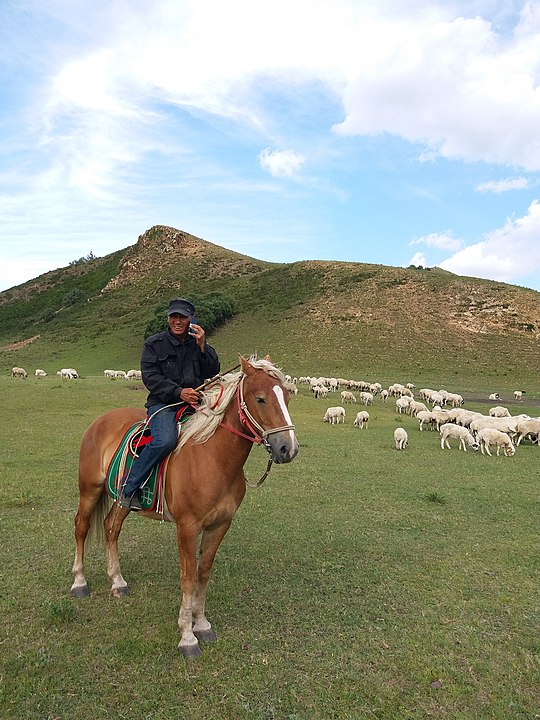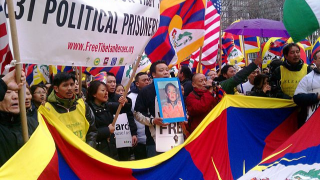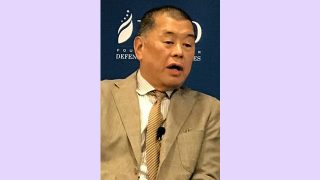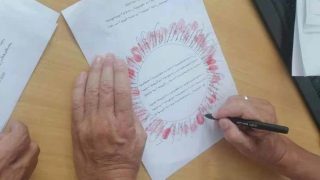An interview with Enghebatu Togochog on how the CCP tries to destroy Mongolian identity in what it calls Inner Mongolia.
by Massimo Introvigne

Enghebatu Togochog is the director of Southern Mongolian Human Rights Information Center (SMHRIC). Bitter Winter discussed human rights abuses and the eradication of Mongolian culture by the CCP in Inner Mongolia (that Mongols prefer to call “Southern Mongolia”) in an article published in June. From his office in New York, Mr. Togochog helps us to further explore the issue.
What is your personal story? How did you end up in New York?
I was born in Southern Mongolia, also known as “Inner Mongolia,” which is a direct translation of the highly Sino-centric Chinese term “Nei Meng Gu.” I was educated in Mongolian, and graduated from the Department of Mongolian Language and Literatures at the University of Inner (Southern) Mongolia in 1994. After four years of work, I went to Japan to study Sociology at the Kibi International University in 1998. In October 1998, I came to the United States, and was granted political asylum there. Since then, I have been living in New York City until today. I obtained my Bachelor of Science and Master of Science degrees from the City College of New York.
History is in itself political. Some Chinese scholars insist that Mongolia – all Mongolia, both the independent Mongolia and present-day Chinese Inner Mongolia – is part of China. Or is China part of Mongolia?
Unfortunately, the majority of Chinese scholars are ill-informed, illogic, and intellectually turbid when it comes to the question of territorial claims and national boundaries. China can lay its territorial claim over any country on our planet, but cannot claim Mongolia as part of its historical territory, because the Chinese themselves have been busy drawing their national boundaries with Mongolia for more than two thousand years. That is the Great Wall, one of the seven wonders of the world, which allegedly is the only man-made structure that can be seen from outer space. Over the past two millennia, China has been reconfirming its national
boundary with Mongolia by building, rebuilding, and fortifying the Great Wall, during every dynastic cycle. The Great Wall indeed not only is the historical and national boundary between these two nations, but also is the boundary of two different civilizations, one agricultural and one pastoral, and two different ways of life, one sedentary and one nomadic. There are no other two neighboring nations in human history that have their national boundary as clean-cut as China and Mongolia.
One of China’s absurd justifications of territorial claim is that “our zhonghua minzu national hero, Chinggis Khan” conquered much of Eurasia, and pushed the “Chinese territorial boundary” to Europe. Unable to stand his fellow countrymen’s absurdity and shamelessness, prominent Chinese writer Lu Xun wrote, “If a nation can shamelessly use its credential of slavery to claim its ruler as its hero, then the Russians have better credentials to say ‘our hero Chinggis Khan,’ because the Russian were ruled by the Mongols longer than we were.”
You prefer to use “Southern Mongolia” rather than “Inner Mongolia.” Why?
Because “Inner” Mongolia is a Chinese creation, a highly propagandistic and Sino-centric term that lays territorial claim over this part of Mongolia. In our own language, we call ourselves “Uvur Mongols,” which means from “Southern Mongolia” or “Southern part of Mongolia”. There is no meaning of “Inner” whatsoever in the Mongolian word “Uvur.” The Chinese intentionally distorted the meaning of “Uvur” and translated it to “Nei” in Chinese, implying “Inner,” or “inside” (of China). In the independent country of Mongolia, traditionally called by the Mongols as “Ar Mongol” or “Northern Mongolia,” there are two provinces called “Ar-Khangai” and “Uvur-Khangai,” whose names are correctly translated into English as “Northern Khangai” and “Southern Khangai,” thanks to the absence of Chinese manipulation in this case. More info on this issue can be found in my opening remarks at one of our conferences.
Southern Mongolia preserves a precious cultural heritage for the world, the ancient Mongolian language written in traditional Mongolian script (while in the independent Mongolia, due to Soviet influence, the Cyrillic script has been adopted). Can you tell us more about this language?
Spoken by nearly 10 million Mongolians in the independent country of Mongolia, Southern Mongolia, Buryatia, and Kalmykia, Mongolian is a member of the Altai Language Family. The traditional or classic Mongolian scripts were adopted from ancient Uyghur scripts in the 13th century, according to Mongolian historical records. However, some linguists argue that the classic Mongolian scripts were adopted and used by the Mongols several centuries before the 13th century. Mongolian was once a lingua franca during the Mongol Empire, the largest contiguous empire in human history.
Diplomatic notes, including the communication between the Mongol Empire and
the Franks, were written in Mongolian. Mongolian letters from Mongol Khans to Popes were found in the Vatican Archives. For example, a letter from Ilkhan Oljaitu to King Philip IV of France was written in Mongolian script. Even after the retreat of the Mongols from China proper, the Ming Dynasty had to use Mongolian in diplomatic communications, owing to its strong influence across Eurasia.
These classic written scripts played a crucial role in unifying all different Mongolian dialects across the vast Mongolian territory. However, after World War II, Mongolia was partitioned into two major parts: Northern Mongolia or the Mongolian People’s Republic, Buryatia and Tuva were placed under the Soviet sphere of influence, while Southern Mongolia was annexed to China as a result of the Yalta Treaty. Northern Mongolia was forced to abandon the classic Mongolian scripts and adopt the Cyrillic scripts. For the purpose of blocking the smooth communication between Southern Mongolia and Northern Mongolia, the Chinese are happy that Southern Mongolia and independent Mongolia continue to use different scripts.
We hear that the Mongolian language is now in danger, as the CCP limits its use in Southern Mongolia. Do you have more details?
A month ago, the Chinese authorities announced that Mongolian elementary and middle schools across Tongliao Municipality, largest Mongolian populated area in Southern Mongolia, must use Chinese as the language of instruction starting this September. The millennia-old classic Mongolian scripts along with the spoken Mongolian will soon be put to an end in Southern Mongolia. After the large-scale physical genocide in the 1960s and 1970s, and the cultural genocide implemented in the past three decades, the Mongolian language was considered the last stronghold to help Southern Mongolians to defend their national identity. All walks of Southern Mongolian society are protesting this policy. There is no sign indicating that the Chinese Government will ever halt this project.
Southern Mongolia suffered enormously during the Cultural Revolution. What did really happen and how many died?
At least 100,000 Southern Mongolians were killed, and half million persecuted, during the Cultural Revolution. The total Mongolian population of Southern Mongolia at that time was only 1.5 million. This means one third of the population was affected by this genocide campaign. Under the pretext of “purging the members of Southern Mongolian People’s Revolutionary Party,” this genocide campaign was designed and orchestrated by the Central Government of China and implemented by the Chinese People’s Liberation Army and Chinese settlers in Southern Mongolia. The aim was to cripple the entire nation of Southern Mongolia physically and spiritually.
My translation of Genocide on the Mongolian Steppe, written in Japanese by Professor Yang Haiying, has first-hand detailed accounts by the survivors.
Do you believe the CCP is deliberately trying to eradicate Mongolian identity in Southern Mongolia?
Yes, by no means Chinese policies toward Southern Mongolia are accidental.
All the policies that the CCP has been implementing in Southern Mongolia, Tibet, and East Turkistan are carefully designed and well planned to achieve their goal, which is to eradicate the Mongolian, Tibetan, and Uyghur identities completely to create a homogenous worry-free Chinese society.
Different national identities not only are considered by the Chinese Government or the CPP as a threat to their regime, but also are perceived by the Chinese populace in general as something inconvenient and uncomfortable. From my personal experience, many Chinese individuals who have no CCP or government background felt uncomfortable and even disappointed when I refuse to identify myself as “Chinese”.
We hear of protests by herders in Southern Mongolia, harshly repressed by the CCP police. What is happening, exactly?
Starting in 2001, the Chinese Government implemented two sets of policies,
called “Ecological Migration” and “Total Ban Over Livestock Grazing,” under
the pretext of “recovering the grassland ecosystem.” The aim of these policies is to completely wipe out rural pastoralist communities, and put an end to the Mongolian nomadic way of life. Herders’ lands are grabbed by the local governments and Chinese extractive industries without free, prior, and informed consent. Thousands of herders who protested illegal land appropriation have been arrested, detained, and imprisoned.
Are Mongolian intellectuals in Southern Mongolia also persecuted?
In Southern Mongolia, intellectuals were the first to be persecuted in all waves of political purges. In the 1950s, tens of thousands of Mongolian intellectuals were persecuted as “national rightists.” During the genocide campaign from the 1960s through the 1970s, intellectuals were purged as “national separatists,” spies of Japanese imperialists, and Soviet and Mongolian revisionists. In the 1980s and 1990s, intellectuals like Mr. Hada, who expressed their opinion on national self-determination, were arrested and sent to long terms in jail. Mr. Hada is still under house arrest, after serving 15 years in prison and 4 years of extrajudicial detention on charges of “separatism and espionage”. Writers like Mr. Lhamjab Borjigin were
arrested, tried, sent to jail, and placed under indefinite house arrest.
What is the status of religious liberty in Southern Mongolia?
Religion has completely been wiped out in Southern Mongolia during the Cultural Revolution. Thousands of Buddhist monasteries were destroyed, and Buddhist monks persecuted. Since then, the Southern Mongolian belief system has never recovered. Some monasteries have been restored only for the purpose of tourism and showcasing of “religious freedom”. Without real religion, religious freedom is nonexistent.
Why the situation in Southern Mongolia is not well-known in democratic countries?
The main reason why the situation of Southern Mongolia is not well-known in democratic countries is that, due to China’s extreme control, Southern Mongolians have never had any opportunity to go into exile in democratic countries, especially the United States and European countries, until fairly recently. The only possible destination, Northern Mongolia, i.e. the independent country of Mongolia, was shut closed for more than four decades until the 1990s.
What is the role of the Southern Mongolia Human Rights Information Center?
The SMHRIC is a human rights organization in exile. All we can do is summarized in two things:
1. Publicize the human rights conditions of Southern Mongolia to the international community;
2. Provide limited consultation services to Southern Mongolians about how to defend their rights and fight for their freedom through peaceful means.
What can democratic countries and NGOs do for human rights in Southern Mongolia?
Although there is no foreign savior for any national movement, democratic countries and NGOs still can play important roles in defending human rights, for example, by helping publicize human rights violations to international human rights bodies and democratic governments; providing training to grassroots leaders to empower the local communities; organizing solidarity movements to provide moral support to human rights defenders; and urging democratic governments to exert pressure on the Chinese government.
Source: Bitter Winter



